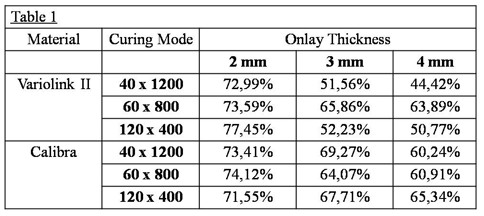ABSTRACT: 1795
Dual cements polymer conversion degree in composite indirect restorations
| G. ADAMI1, P.A. ACQUAVIVA1, A. PUTIGNANO2, M. GAGLIANI3, L. TACCHINI1, and A. CERUTTI1, 1University of Brescia, Italy, 2Polytechnic University of Marche, Ancona, Italy, 3University of Milan, Italy | |
Objectives: In this study was evaluated the conversion degree of dual composite materials employed for the cementation of indirect restorations. Methods: 90 onlays (Signum composite – Heraeus - A2 shade) of different thickness (2 mm, 3 mm, 4 mm) were prepared. The cements considered (two dual-curing cements - Variolink II – Ivoclar-Vivadent - and Calibra - Dentsply) were cured with the same halogen lamp (Swiss Master Light – EMS) according to three different modalities (1200 mW/cm2 X 40 s, 800 mW/cm2 X 60 s, 400 mW/cm2 X 120 s.) selected to provide a constant quantity of energy to the material (48 J). Specimens were cured interposing the cement between a glass plate and an indirect restoration (onlay); the curing tip was shielded so that the light reached the composite material only passing through the onlay. Each sample was examined in three points (centre, middle, near the margins) using the Micro-Raman Dilor HR LabRam spectrometer to evaluate the polymer conversion degree. The data obtained were analyzed by ANOVA test (p-value <. 0001). Results: Results were evaluated considering the thickness of the onlay and the polymerization mode applied. Curing Variolink II at 800 mW/cm2 for 60 high conversion degrees were obtained even with the interposition of 4mm thick restoration. Calibra obtained more uniform results for all the modalities used. Conclusion: With the limitations of this study, data evidenced that both dual-curing cements need a custom curing mode to obtain the best conversion rate.
| |
| Seq #187 - Polymerization Processes 2:00 PM-3:15 PM, Friday, July 4, 2008 Metro Toronto Convention Centre Exhibit Hall D-E | |
|
Back to the Dental Materials 5: Polymer-based Materials - Chemistry and Composition Program | |
©Copyright 2008 American Association for Dental Research. All Rights Reserved.
